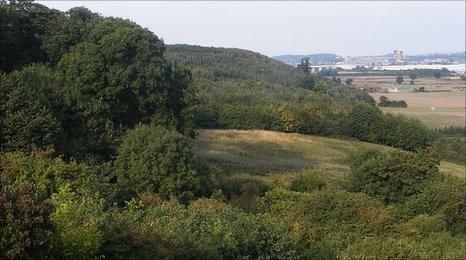Mercian Trail highlights history of Saxon Staffordshire
- Published

On Battlestead Hill overlooking Burton a great battle was fought in the Saxon era - but details of it are sketchy
Positive reactions to the tour of the Staffordshire Hoard round the county in summer 2011 have produced new interest in the county's Saxon past.
A tourist route, The Mercian Trail, tracing the county's Anglo-Saxon era, is being developed.
It aims to encourage the study of the history of places and artefacts associated with the kingdom of Mercia.
The Hoard treasure trove, comprising 1500 objects from about 700, was found buried in a field in 2009.
The kingdom of Mercia, which had the area now known as Staffordshire as its base, flourished between 600 and 1000.
See photo-gallery: Looking for evidence of Saxons in Staffordshire
The Mercian Trail Partnership brings together in partnership Birmingham Museum & Art Gallery, The Potteries Museum & Art Gallery, Lichfield Cathedral, Lichfield District Council, Tamworth Borough Council and Staffordshire County Council.
In summer 2011, selected items from the Hoard itself follow the route going to Stafford, Lichfield and Tamworth, anticipating the more developed trail.
Canon Pete Wilcox of Lichfield Cathedral, speaking about the Staffordshire Hoard show which comes to Lichfield in August 2011, said thousands of tickets to see it had been sold.
He said: "It just shows how much the Mercian Trail route could add to the region."
The rise of Mercia
Because virtually no documents, artefacts or buildings survive from of the Saxon period in the north Midlands, the details of the story of Mercia is little-known, despite its fame.
In the middle of the sixth century, the invading Angles, who had originally come from Germany, pushed up the River Trent. They displaced the 'Britons' living here, and became the new force in the area we now call Staffordshire.
They gained the name of Mercians, which derives from their description as 'men of the March', the March being word for the frontier lands between England and Wales.
By 700, which is when the Staffordshire Hoard is believed to date from, Mercia was one of the seven great kingdoms of England that were known as the Heptarchy - but it soon also became the strongest and biggest.
Under the mighty king Offa, Mercian power reached from Chester to London and from Wales to East Anglia.
Capital Tamworth
Despite the size of his kingdom, Offa maintained a capital in Staffordshire - at Tamworth, where he erected a palace.
Around Tamworth, Offa even built a small dyke (or trench) - of which some traces can still be seen today. It is a miniature of his most famous fortification, known as Offa's Dyke, which ran along the Welsh border and which was designed to halt any Welsh raiding into his territories.
But fortunes ebbed and flowed for the kingdom, and during the ninth century Danish/Viking invasions from the east into their lands sapped the strength of this huge power, and it shrank again.
Mercians concentrated on defending their heartlands around Staffordshire, with their most famous queen, Ethelfleda (also known as Aethelflaed), the daughter of King Alfred the Great, fortifying Stafford as well as re-building Tamworth.
Ethefleda's fortification of Stafford is seen as the beginning too of the idea of something called Staffordshire. She died at Tamworth in 918.
And fall...
However, in 919, Mercia, now reduced to the area of what we know now as Staffordshire and the West Midlands, was absorbed into the new kingdom of All England.
The last time we hear of the Mercians as a force is one of the most terrible.
After the Normans invaded England in 1066, the then Earl of Mercia, then based nearer Coventry, was not prepared to deal with William The Conqueror, and his forces rose in rebellion.
But the new Norman king crushed this rebellion ruthlessly; so much so, that the Domesday Book of a few years later recorded that in the ares of Staffordshire there were only 3,000 men alive, and hardly a church standing to speak of.
Mercia lives
The Mercian Trail tourist route will attempt to highlight this largely forgotten history.
However, the name of Mercia still survives in unexpected places.
The regiment which takes recruits from Cheshire, Staffordshire and the West Midlands calls itself the Mercian Regiment.
The 'Forest of Mercia' stretches from Penkridge to Lichfield, and Walsall to Cannock Chase in south-west Staffordshire.
The West Mercia Police Service covers Herefordshire, Worcestershire and Shropshire.
The Mercian Way is a cycling route in Shropshire.
An organisation called The Acting Witan campaigns for the freedom of the Mercian region.
-------
Check our other Mercian-Staffordshire pages for histories of the heroes, the legends, the places, the saints.
- Published4 April 2011
- Published16 April 2011